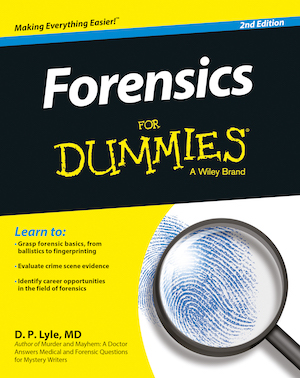
Former Heavyweight Champion Sonny Liston is best remembered from his two losses—first to Cassius Clay, then Muhammad Ali. Ali changed his name between the two fights. But Sonny was a tough guy. He ruled the heavyweight division with an iron hand. Until Ali burst of the scene anyway.

But Sonny was no match for the needle. The cause of his death is easy—-a heroin OD. But, the manner of death isn’t so apparent. A situation not uncommon in drug OD deaths.
The cause of death is what actually killed the person while then manner of death is the by whom and why. It basically comes down to—-by whose hand and for what purpose did the death occur?
The four (plus one) manners of death are: Natural, Accidental, Suicidal, Homicidal, and Undertermined—-the latter a fancy way of saying “I don’t have a clue.”
A heroin OD is not natural but can it be accidental, or suicidal, or homicidal? You bet. And it’s not always possible to determine the manner in heroin-related deaths.

FROM FORENSICS FOR DUMMIES:
Uncovering the four manners of death
The manner of death is the root cause of the sequence of events that leads to death. In other words, it answers these questions:
# How and why did these events take place?
# Who or what initiated the events and with what intention?
# Was the death caused by the victim, another person, an unfortunate occurrence, or Mother Nature?
The four manners of death are
Natural: Natural deaths are the workings of Mother Nature in that death results from a natural disease process. Heart attacks, cancers, pneumonias, and strokes are common natural causes of death. Natural death is by far the largest category of death that the ME sees, making up over half of the cases investigated.
Accidental: Accidental deaths result from an unplanned and unforeseeable sequence of events. Falls, automobile accidents, and in‐home electrocutions are examples of accidental deaths.
Suicidal: Suicides are deaths caused by the dead person’s own hand. Intentional, self‐inflicted gunshot wounds, drug overdoses, and self‐ hangings are suicidal deaths.
Homicidal: Homicides are deaths that occur by the hand of someone other than the dead person.
Undetermined or unclassified: These are deaths in which the ME can’t accurately determine the appropriate category.
Just as causes of death can lead to many different mechanisms of death, any cause of death can have several different manners of death. A gunshot wound to the head can’t be a natural death, but it can be deemed homicidal, suicidal, or accidental.
Though the ME can usually determine the manner of death, it’s not always easy, or even possible. For example, the manner of death of a drug abuser who overdoses is most likely to be either accidental or suicidal (it also could be homicidal, but it’s never natural). When the cause of death is a drug overdose, autopsy and laboratory findings are the same regardless of the victim’s or another’s intent. That is, the ME’s findings are the same whether the victim miscalculated the dose (accidental), intentionally took too much (suicidal), or was given a lethal dose (homicidal). For example, perhaps the victim’s dealer, thinking the user had snitched to the police, gave the victim a purer form of heroin than he was accustomed to receiving, so that his “usual” injection contained four or five times more drug than the unfortunate soul expected. Simply put, no certain way exists for determining whether the person overdosed accidentally, purposefully, or as the result of another’s actions. For these reasons, such deaths are often listed as Undetermined.
So was Sonny’s death an accident? A suicide? Or did the hand of another intervene and murder Sonny? We may never know.
Was Sonny Liston Murdered?: http://theundefeated.com/features/was-sonny-liston-murdered/







































